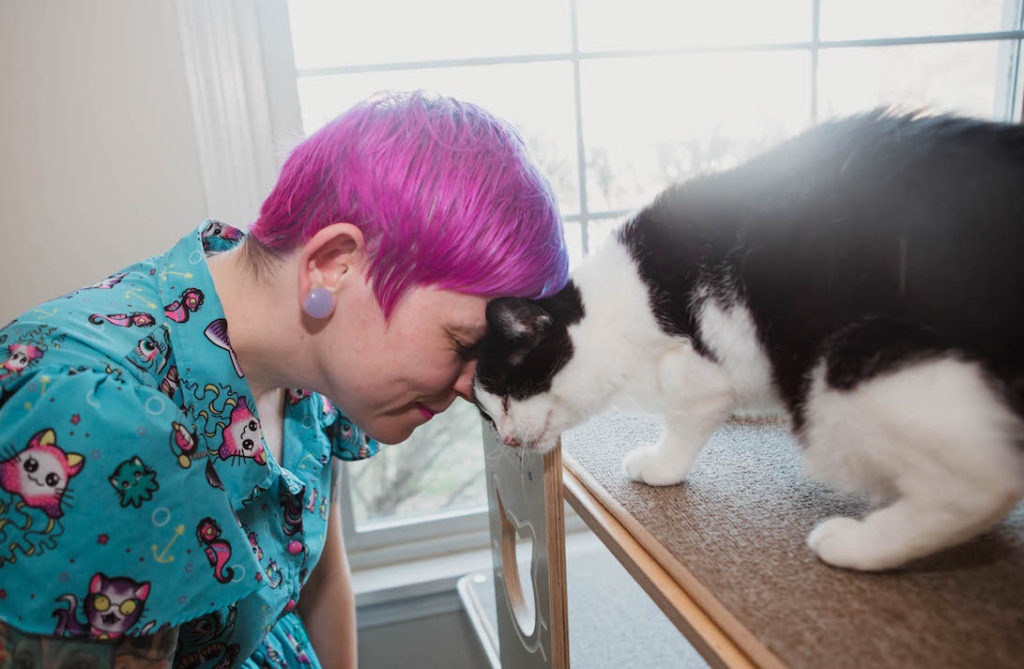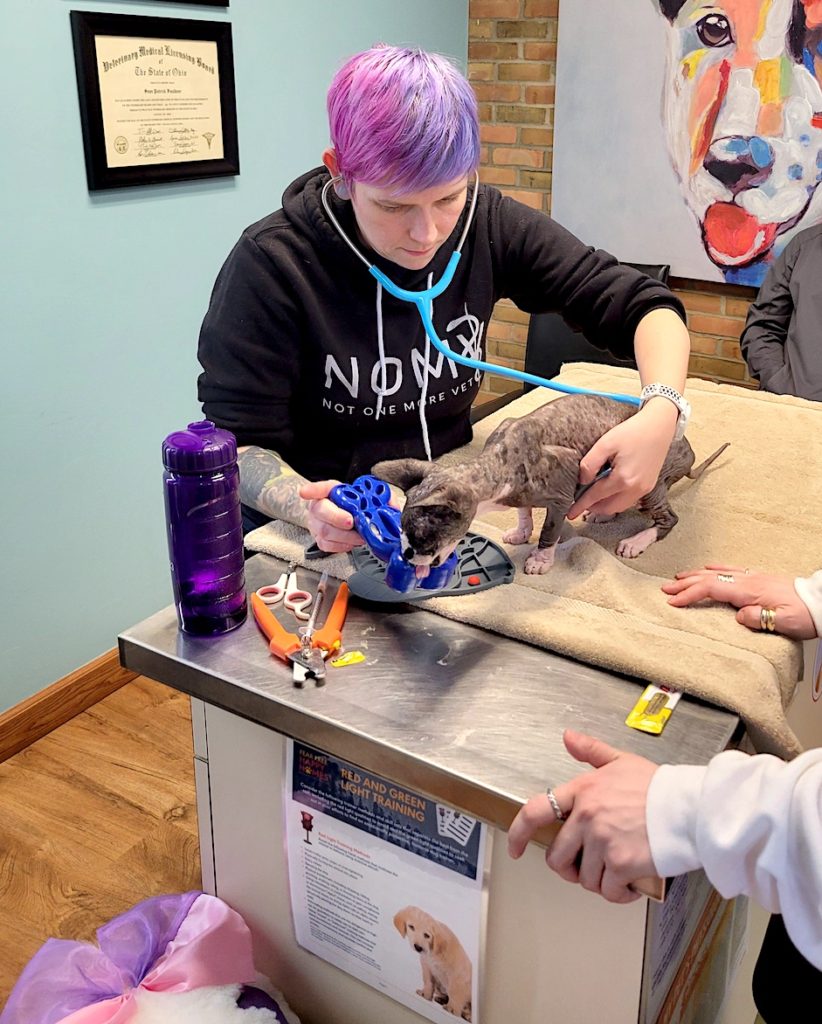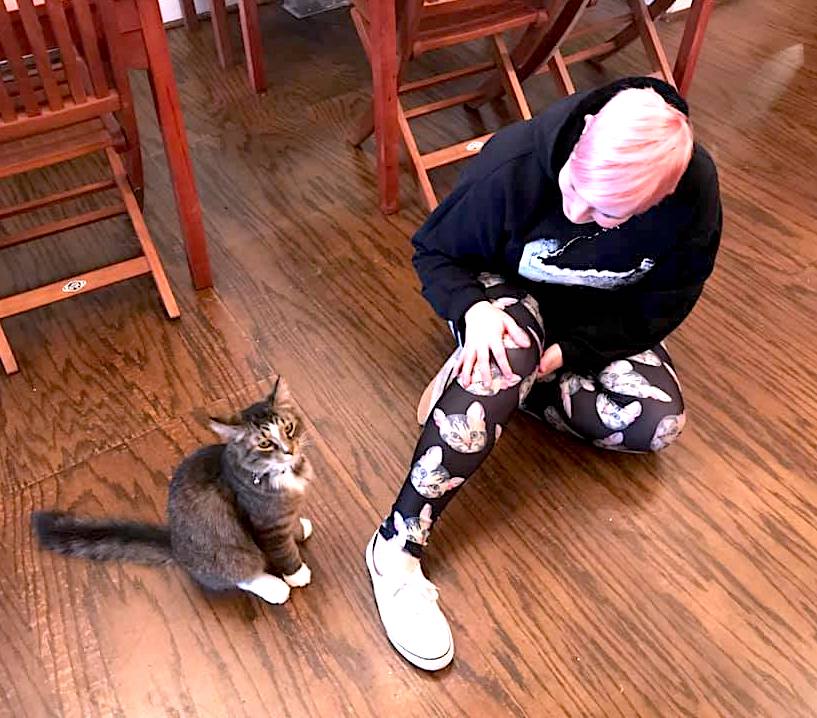
For as long as she can remember, Tabitha Kucera (CCBC, RVT, KPA-CTP, VTS) has had a strong connection with animals and knew that she wanted to work with them in her professional and personal life.
She began volunteering with animal rescues in high school. Once Tabitha graduated high school, she wanted to continue to help animals and she went to school to become a veterinary technician. She graduated and passed her board exam in 2010 becoming a registered veterinary technician.
As a veterinary technician, Tabitha worked with animal rescue organizations and in general practice. Her work in these fields shed light on repeated occurrences of animal euthanasia and re-homing due to behavior issues, misreading of animal body language, and the suffering that animals and humans endured due to them being misunderstood. This is what first inspired her to become more interested and knowledgeable about animal behavior and training. She quickly became dedicated to learning about the root causes and permanent solutions to feline and canine behavior concerns,
Today, Tabitha is a Veterinary Technician Specialist (VTS) in Behavior, a CCBC (Certified Cat Behavior Consultant through the International Association of Animal Behavior Consultants), and a KPA-CTP (Karen Pryor Academy Certified Training Partner) Elite Fear Free and Low-Stress handling certified. Her passion and knowledge make her a much sought-after trainer and educator.
Tabitha often speaks about animal care and behavior to animal caregivers, veterinary professionals, and shelter professionals. She is also host of the Tails from a Vet Tech podcast, and a Fear Free Certified Speaker and Practice Certification Consultant. Her website, Chirrups and Chatter, has tons of helpful information about how to be a great pet parent and information about how to book Tabitha for an animal behavior consultation.
Mewla: Welcome Tabitha! You are such a fantastic champion for pets! We are psyched to have you with us today and have a lot of questions!
You must have worked with hundreds of human caregivers by now. What is one of the most consistent mistakes you’ve seen humans make that puts them at odds with their cat companions?

Tabitha: Lack of understanding of their cat’s body language and due to this, instead of describing behavior, caregivers use labels like ‘spiteful.’
Cats don’t do things to spite us, and unlike humans, cats don’t do things out of spite. Often the animal is struggling with a behavior and/or medical issue along with not having their physical and mental needs met (often due to boredom). We commonly interpret animals’ feelings based on human body language and not cat body language, and this can be damaging.
For example, if a caregiver thinks their cat(s) are going to the bathroom outside of the litter box out of spite, they are more likely to approach this issue negatively, which will escalate the issue and damage the bond with their cat.
If they address the actual causes (stress, fear, anxiety, or a medical issue), the owners will approach the issue empathetically and get the cat the help they need to resolve the issue.
Mewla: So true! I imagine that this one skill could make or break a happy cat caregiver. I’m also curious about your training in Low-Stress Handling techniques. Can you share an important skill (attitude/philosophy etc.) you learned when you trained for your Low-Stress Handling and Elite Fear-Free certifications?
Tabitha: Throughout my career in veterinary medicine and behavior, I have learned and applied that physical and emotional health are equally as important.
Utilizing low-stress, fear-free, and compassionate handling is important because it allows us as veterinary professionals not only to address our patient’s physical well-being but also their emotional well-being.
Also, handling is a skill that, like any skill, takes time and practice to improve. As veterinary professionals, a critical thinking approach needs to be done when we approach any medical issue. When approaching handling critically and investing in handling as a skill, it reduces time, keeps people safer, reduces stress and pain for animals, reduces stress for humans, utilizing less staff and anesthesia/sedation which saves money, and more!
All cats are individuals. We need to assess the cat’s body language and be flexible with handling techniques based on the cat’s individual preference. This includes allowing the cat to maintain their chosen position and vary your touch with the cat’s response. For example, many people’s initial response is to walk up to a cat and immediately scruff the cat while sometimes also physically manipulating them to go on their side. If the cat begins to struggle, hold them down firmly.
A better strategy is to approach the cat in a calm and soothing manner, avoiding direct eye contact and a frontal approach. Assess your body language: when we are calm, the cat is more likely to be calm too. Assess the cat’s body language: if fearful, allow the cat to stay where she is (at the bottom of the carrier, for example) and use a towel to provide a hiding place, lightly swaddling the cat and allowing her to maintain her choose a position (like sitting up).

All cats are individuals. We need to assess the cat’s body language and be flexible with handling techniques based on the cat’s individual preference. This includes allowing the cat to maintain their chosen position and vary your touch with the cat’s response. For example, many people’s initial response is to walk up to a cat and immediately scruff the cat while sometimes also physically manipulating them to go on their side. If the cat begins to struggle, hold them down firmly.
A better strategy is to approach the cat in a calm and soothing manner, avoiding direct eye contact and a frontal approach. Assess your body language: when we are calm, the cat is more likely to be calm too.
Assess the cat’s body language: if fearful, allow the cat to stay where she is (at the bottom of the carrier, for example) and use a towel to provide a hiding place, lightly swaddling the cat and allowing her to maintain her choose a position (like sitting up).allowing her to maintain her choose a position (like sitting up).
Mewla: How wonderful! This approach is so respectful of the cat and really does show so much empathy.
Will you tell us about a particular surprise you experienced when helping to improve someone’s relationship with their animal companion?
Tabitha: I do a lot of inter-cat aggression cases and these can be complex and difficult. I have stages where I address the cats’ needs and introduce them.
With this one client, we were at the supervision stage which is close to them living in the same space and being out with each other. I’d already taught their caregivers tools and had management in place. It was the first time, so I set realistic goals and we had plans to redirect when the cats became aggressive. However, the cats approached each other beautifully with relaxed body language and began doing an appropriate greeting. Both me and the cat caregivers’ mouths dropped in surprise and happiness.
When we go to this supervision step for the first time, we are utilizing management and redirection tools (recall, redirecting with play or a toy, cueing to a mat, etc). In this case, the cats were only am I comfortable with the other cat in the room with me but they approached each other with a kind cat greeting!
Mewla: It’s as if those two cats were just waiting for their caregiver to have the knowledge to support them, lol. But I imagine that it’s usually much harder than that.
Animals amaze me every day. We work to change their emotional state from fearful to positive, but that takes time. You tend not to see that kind of response the first time. That was amazing because I do what I can to set up animals for success. I don’t push them. I work with each individual animal, but you can’t ever say when these things are going to happen. Behavior is not guaranteed.
Mewla: It sounds like you make room for caregivers to allow cats to have the best possible relationship they can with their caregivers and fellow housecats. That’s so cool.
I know you spent several years working in veterinary clinics, as well. Will you tell us a story about how you put your training into place in the clinic?
Tabitha: In a lot of the clinics I worked at, I was the person to first start to implement Fear-Free. I’m not a proponent of declawing. In the interview process, I asked the clinics if they declawed and if they were open to educating clients and having me create resources about [the harms] of declawing and how to prevent destructive scratching. They were super open to it, so as a technician in my contract I said I will not be assisting in declawing for my ethical well-being and I set clear boundaries.
Over time, we worked together as a clinic to create resources to educate clients and shared research on the negative effects of declawing to staff, and I created scripts for us to practice when it came to having the conversation of We will not declaw your cat but let’s talk about preventing destructive scratching and why we won’t declaw.
These conversations can be difficult because clients will come in and say things like, “I will euthanize my cat if they are not declawed” and that’s where effective communication is huge! The huge win was by the time I left that practice, the practice was officially not offering the declawing procedure anymore but also had tools to educate clients.
Mewla: Awww, How wonderful to think of the number of cats you’ve saved from this cruel, unnecessary procedure. And your educating caregivers on how to redirect a cat to scratching posts, for example, also gives you the opportunity to share your insights about how to understand cats’ physical and emotional needs, rather than them labeling the behavior as “bad”. A true win-win!
I love your recommendations about how to help humans better care for their cats. You also have important insights about figuring out if a cat is in pain. Will you share some of your wisdom?
Tabitha: I have created numerous resources and content to educate caregivers on pain in their cats. You can find these on Chirrups and Chatter’s Facebook and Instagram pages, as well as download my free advocating for your pet at the vet and cat pain handouts on my website along with other resources at my website, chirrupsandchatter.com.
A few recommendations to start:
It’s important to know your pet’s normal temperament and behavior. This includes your pet’s normal attitude, energy level, appetite, sleep patterns, and other physical and behavioral patterns. Just the slightest change could be a sign your pet is sick or in pain.

Since your pet cannot tell you it’s in pain, your veterinarian relies on you to determine if any abnormal behavior patterns could be pain-related. If your pet is just not acting like themselves, this can be a sign that they are experiencing pain.
Your cat is communicating with you all of the time. They use their body to show you when they’re feeling comfortable and when they’re feeling sore or unwell. My handouts will teach you how to read the signs and signals that your cat is in pain and how to evaluate your cat’s body language.
Learn your cat’s “normal” and pay attention to any changes. It can be helpful to keep a diary to track appetite, vomiting, bowel movements, etc.
Know the signs of pain.
Changes in your cats’ daily habits should not always be attributed to aging. Age is not a disease, but as your cat ages they are more likely to be suffering from pain
Advocate for your cat
EVERY VET EXAM SHOULD INCLUDE 2-3 SHORT VIDEOS OF YOUR CAT ACTING “NORMAL”
Mewla: This is such helpful advice, and the resources on your website are outstanding. Thank you for helping to bring these important issues to the cat caregiver community! I hope everyone reading this today will pass on these hints, as well.
So, you obviously have quite a bit of experience with animals. When did you first fall in love with pets, and what was it that made you fall in love with them?
Tabitha: I fell in love with animals as a child and my love of animals has grown over the years as I have learned to better understand them. I grew up with cats, dogs, turtles, rabbits, and more. All my experiences with cats and dogs have been memorable and have strengthened my love for them. They have taught me so much and continue to do so and have provided love and companionship through the good and hard times in life.
Mewla: And who are the pets in your life today?
Tabitha: My cats, JellyBean, Chip, Norman Squeakers, Cupcake, and Malt, and my dog, Ness. My amazing animals have and continue to teach me so much as well as bring me joy during the challenging days on the job.
Mewla: Well, you have a wealth of knowledge about cats. It’s been a joy to speak with you today, Tabitha! Thank you so much for joining us, sharing your amazing cat wisdom, and for all you do to keep animals in safe and loving homes!
🐾🐾Learn more about Tabitha and her business at https://chirrupsandchatter.com/
🐾🐾Listen to “Tails from a Vet Tech” at: https://tailsfromrvt.buzzsprout.com/
Please leave your comments or questions
about the Tabitha Kucera article below.
Do you have a request or suggestion? Send us a message via our Contact Us page.




JellyBean, Chip, Norman, Squeakers, Cupcake, and Malt are lucky animals. Great article and congratulations to Tabitha on being Cat Person of the Month!
Great insights from a true cat woman! Thanks for the article!
Thank you Mewla. This is an excellent article!
Congratulations Tabitha! You’ve taught me a lot about what makes cats tick.